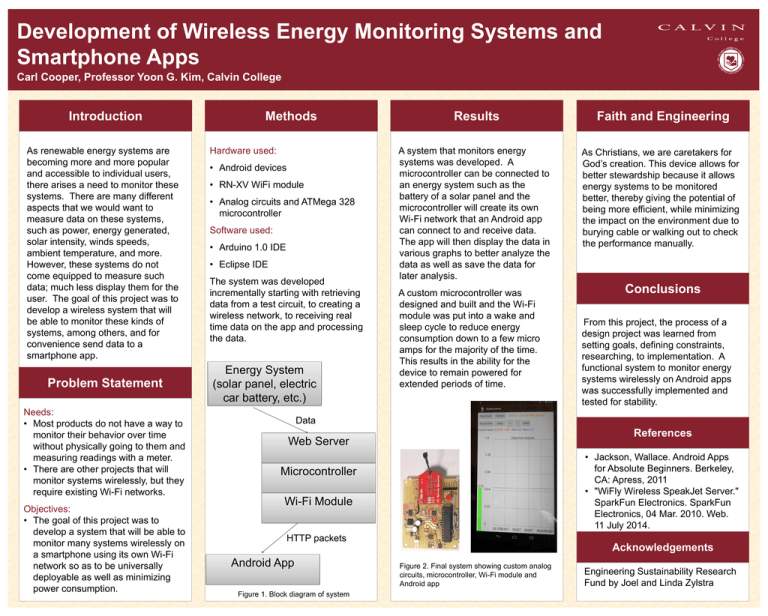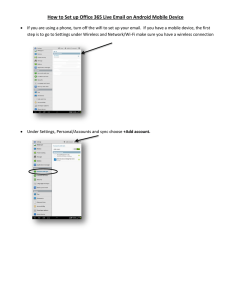Development of Wireless Energy Monitoring Systems and Smartphone Apps Introduction Methods
advertisement

Development of Wireless Energy Monitoring Systems and Smartphone Apps Carl Cooper, Professor Yoon G. Kim, Calvin College Introduction As renewable energy systems are becoming more and more popular and accessible to individual users, there arises a need to monitor these systems. There are many different aspects that we would want to measure data on these systems, such as power, energy generated, solar intensity, winds speeds, ambient temperature, and more. However, these systems do not come equipped to measure such data; much less display them for the user. The goal of this project was to develop a wireless system that will be able to monitor these kinds of systems, among others, and for convenience send data to a smartphone app. Problem Statement Needs: • Most products do not have a way to monitor their behavior over time without physically going to them and measuring readings with a meter. • There are other projects that will monitor systems wirelessly, but they require existing Wi-Fi networks. Objectives: • The goal of this project was to develop a system that will be able to monitor many systems wirelessly on a smartphone using its own Wi-Fi network so as to be universally deployable as well as minimizing power consumption. Methods Hardware used: • Android devices • RN-XV WiFi module • Analog circuits and ATMega 328 microcontroller Software used: • Arduino 1.0 IDE • Eclipse IDE The system was developed incrementally starting with retrieving data from a test circuit, to creating a wireless network, to receiving real time data on the app and processing the data. Energy System (solar panel, electric car battery, etc.) Results Faith and Engineering A system that monitors energy systems was developed. A microcontroller can be connected to an energy system such as the battery of a solar panel and the microcontroller will create its own Wi-Fi network that an Android app can connect to and receive data. The app will then display the data in various graphs to better analyze the data as well as save the data for later analysis. As Christians, we are caretakers for God’s creation. This device allows for better stewardship because it allows energy systems to be monitored better, thereby giving the potential of being more efficient, while minimizing the impact on the environment due to burying cable or walking out to check the performance manually. A custom microcontroller was designed and built and the Wi-Fi module was put into a wake and sleep cycle to reduce energy consumption down to a few micro amps for the majority of the time. This results in the ability for the device to remain powered for extended periods of time. Conclusions From this project, the process of a design project was learned from setting goals, defining constraints, researching, to implementation. A functional system to monitor energy systems wirelessly on Android apps was successfully implemented and tested for stability. Data References Web Server • Jackson, Wallace. Android Apps for Absolute Beginners. Berkeley, CA: Apress, 2011 • "WiFly Wireless SpeakJet Server." SparkFun Electronics. SparkFun Electronics, 04 Mar. 2010. Web. 11 July 2014. Microcontroller Wi-Fi Module HTTP packets Android App Figure 1. Block diagram of system Acknowledgements Figure 2. Final system showing custom analog circuits, microcontroller, Wi-Fi module and Android app Engineering Sustainability Research Fund by Joel and Linda Zylstra



